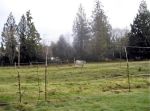Last spring, I was browsing the Internet, looking for something to do with antennas. Here at the farm I had put up two Windom antennas (one works great, and the other, well, it just works). And the XYL and I had already assembled a TAK-Tenna that now needs to be relocated and may need new coax. (Some of the stuff you get for free is free for a good reason!)
I stumbled onto some information about “The Gentleman’s Band” (160 meters) and discovered it needs a lot of wire or some other really large antenna. Scanning through articles in many publications I saw one that looked doable: a horizontal loop antenna. I had the real estate, but I didn’t have the trees to get the antenna to the recommended height above ground.
Being a person who enjoyed experimenting, and influenced by my USAF “hang it on something and get on the air NOW” background, I stuck some electric fence insulators on top of the fence posts around the pasture. I then rolled out approximately 375 feet of #17 aluminum wire. (Why? Because that’s what I had on hand!)
Being unable to solder aluminum wire I simply made the wire fast at the insulator by using no less than ten tight back wraps, as you would do when splicing fence wire. Then I ran a 50-foot RG8 coax cable from the Delta 4 switch to the joint on either side of the insulator, and fastened it with heavy gator clips soldered to the coax shield and center lead.
Setting the Kenwood TS480 radio on 5 watts output, I donned my personnel safety equipment, and shouting “Lock and load!” I punched the PF button on the Kenwood, and lo and behold, nothing fried.
Using the MFJ 929 antenna tuner in the antenna system, it came up with the following readings:12 watts forward power, 1.4 watts reflected.
That night I found a group of operators on 1.841 MHz and checked for signal with stations in western Washington, one in eastern Oregon, and one in Montana, and received reasonable but not great reports.
After thinking about it, I decided the actual two-strand fence wires might be eating some of my signal or possibly acting as a reflector and creating an NVIS situation. What to do? Raise the loop! I hog-wired six-foot fiberglass electric fence posts to the top of the existing fence posts and thus raised my loop to somewhere around 12 feet above ground.
Those of you who are not in total misbelief or hysterics will be interested to note that meter readings for the tuner now read: 11 watts forward power, 0.5 watt reflected, for a 1.5 SWR at 1.805 MHz lower side band. At 1.995 MHz, readings are 12 watts forward power, 0 watt reflcted and 1.0 SWR, obviously a sweet spot for this setup.
But that’s not all! Other frequencies showed surprisingly good results:
- At 3.968 MHz — 13 watts forward power, 1.0 watt reflected, 1.7 SWR.
- At 3.700 MHz — 13 watts forward power, 0 watt reflected, 1.0 SWR.
- At 7.100 MHz — 13 watts forward power, 0 watt reflected, 1.0 SWR.
- At 7.290 MHz — 13 watts forward power, 0 watt reflected, 1.0 SWR.
- At 14.200 MHz — 13 watts forward power, 0.3 watt reflected, 1.3 SWR.
- At 14.290 MHz — 13 watts forward power, 0.8 watt reflected, 1.6 SWR.
The antenna also works on 6 and 10 meters. For example, our local Monday night net on 53.030 MHz tunes up at 44 watts forward power, 1.1 watt reflected SWR 1.3.
Next spring, I plan to install some 30-foot logs to raise the loop even higher. Getting them in the ground and set up may be a challenge but we’ll get-er done!
Story by Ray de KE7PHU



I am very interested in trying a horizontal loop. What a great story, Ray. Thanks for the inspiration!
LikeLike
A Horizontal loop antenna is a real nice antenna. All the hams I know that have built one have been happy with their results.Great story Ray.
LikeLike
have a 40 meter loop up at 40 feet and with a icom 746pro will tune all bands up to 10 meters seems to be quiter than a dipole an works 360 o have no problem into poland and to the easy have also worked new zealand will try a 160 loop as i have ten acres at the farm to use. any help on design or best height would be welcome STAN KA4DSK DELAND FL.
LikeLike
Mine is still in experemental mode. I have 35 ft poles to set up and when wx dries some ill drill holes. A friend has a large back hoe with a grabber and will come over and drop in the holes. Got all the data from
Click to access 9467_2192.pdf
mine is aprox 325 feet, only about 10 feet on avrg. BEING LEVEL IS Crit, Web site above is better than stuff from me. use aluminum electric fence wire very sucessfully (Cheap)
LikeLike
I’ve been experimenting with horizontal loop antennas for over 20 years on the 40 and 80 meter bands. They are quiet on receive and are ideally suited to my operating style. Next, I’d like to see how a larger one, for 160, at low elevation works.
73,
Evan
LikeLike
I just ordered an Autek antenna analyzer to get some low NVOS dipoles working here in Tampa. 160 meters fascinates me, but my roof is small to support such large antennas. I have a large chain link fence and want to try some low NVIS wires mounted on top of it, and see what happens ?
LikeLike